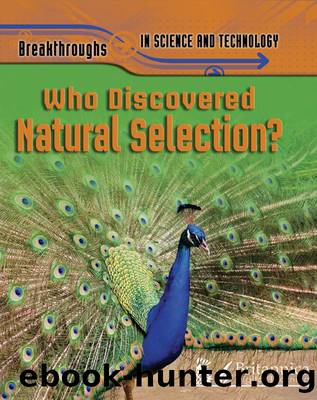Who Discovered Natural Selection? by Anna Claybourne

Author:Anna Claybourne
Language: eng
Format: epub
ISBN: 9781625133137
Publisher: Britannica Digital Learning
Published: 2015-02-19T00:00:00+00:00
Flowers attract bees, which collect nectar from them, using their long tongues. They also collect pollen on their legs. The bees carry pollen from flower to flower, pollinating the plants, so they can produce seeds. Darwin wondered how it could be that two living things could develop to depend on each other in this way.
⢠Very different creatures all had similar bodies. For example, humans, birds, bats, and lizards all had a backbone, ribs, four limbs, two eyes, and so on. Had they all developed from one original type of animal?
Nature selects
Darwin was especially interested in selective breeding and how breeders selected the qualities they wanted in their animals. Was something like this happening in nature?
Darwin exchanged letters with many selective breeders. One was William Bernhard Tegetmeier, a leading authority on poultry. In an 1856 letter, Darwin asked for samples of different breeds: âI should be glad of anything . . , which you consider a distinct breed. I should be willing to go to 5s [5 shillingsâhalf a dollar, or 25 p today] per bird.â
Human struggles
Darwin was also influenced by the work of a British philosopher, Thomas Robert Malthus. His most famous work was An Essay on the Principle of Population, which he published first in 1798. In it, he said that when the human population increased, people had to struggle for food and work. The weakest and poorest often died young or were swept away by famines and disease.
Darwin saw that this could apply to all living things. Animals often had too many young and most plants made too many seeds for them all to survive. What was special about the survivors? They must be selectedâby nature.
Download
This site does not store any files on its server. We only index and link to content provided by other sites. Please contact the content providers to delete copyright contents if any and email us, we'll remove relevant links or contents immediately.
Pale Blue Dot by Carl Sagan(4907)
Cracking the GRE Premium Edition with 6 Practice Tests, 2015 (Graduate School Test Preparation) by Princeton Review(4224)
Pocahontas by Joseph Bruchac(4182)
Unfiltered by Lily Collins(3956)
The Emotionary: A Dictionary of Words That Don't Exist for Feelings That Do by Eden Sher(3316)
The Daily Stoic by Holiday Ryan & Hanselman Stephen(3230)
Factfulness_Ten Reasons We're Wrong About the World_and Why Things Are Better Than You Think by Hans Rosling(3197)
The President Has Been Shot!": The Assassination of John F. Kennedy by Swanson James L(3048)
The 48 laws of power by Robert Greene & Joost Elffers(3023)
Sapiens and Homo Deus by Yuval Noah Harari(2986)
Rogue Trader by Leeson Nick(2975)
The Innovators: How a Group of Hackers, Geniuses, and Geeks Created the Digital Revolution by Walter Isaacson(2827)
The Rape Of Nanking by Iris Chang(2773)
Gettysburg by Iain C. Martin(2771)
Almost Adulting by Arden Rose(2660)
The Plant Paradox by Dr. Steven R. Gundry M.D(2543)
In the Woods by Tana French(2530)
500 Must-Know AP Microeconomics/Macroeconomics Questions(2529)
Make by Mike Westerfield(2287)
